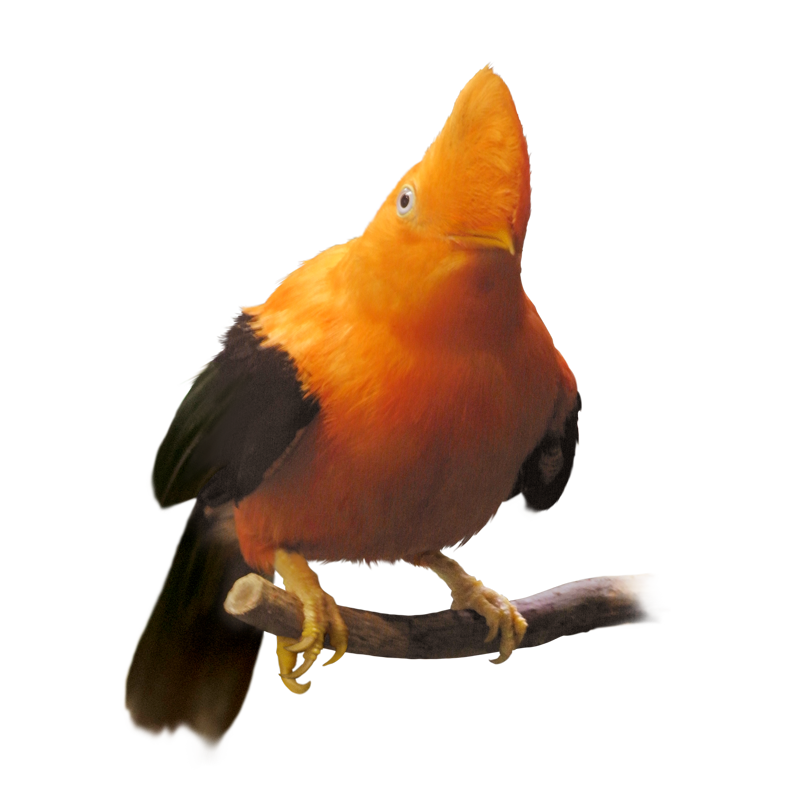
Rupicola peruvianus (Latham, 1790)
選ばれるための舞台
A Stage Built to Be Chosen
全長は約30cmです。南米アンデス山脈の亜熱帯域や湿潤な雲霧林に生息しています。雄と雌で姿が異なる性的二型であり、雄は大きな円盤状の冠羽と鮮やかなオレンジ色の羽を持ち、雌は冠羽が発達せず暗褐色の羽に覆われています。イワドリという名は、森の小川近くの岩壁や渓谷にすむ習性に由来します。鳴き声も独特で、姿が見えなくてもよく響きます。
繁殖期になると、雄はレック(lek)と呼ばれる場所に集まり、羽ばたいたり跳ねたり鳴いたりして、雌の注意を引こうとします。雌はその中から気に入った雄を選び、交尾を終えると単独で巣を作り、産卵から育雛までを一羽で行います。
雄は交尾が終わると再びディスプレイを行い、別の雌を惹きつけようとします。つまり雄は求愛と交尾に特化した役割を持ち、雌や子育てには関わりません。しかし、すべての雄が交尾できるわけではなく、ごく少数の雄が大半の交尾を独占します。選ばれる雄は冠羽が大きく羽色が明るい傾向があり、レックの中央など目立つ位置を占めます。また、動きの滑らかさや周囲との調和も評価されるようです。
レックという繁殖様式には、多くの雄を同時に比較できる効率性や、警戒を共有することでの捕食回避、そして有利な形質が子孫に伝わる性淘汰などの利点があります。鳥類ではアンデスイワドリのほか、マイコドリやキジオライチョウなどにも見られ、哺乳類ではカモシカの仲間であるウガンダコーブが知られています。
It reaches about 30 cm in length and inhabits the subtropical zones and humid cloud forests of the Andes Mountains in South America. This species shows clear sexual dimorphism: males have large, disk-shaped crests and brilliant orange plumage, while females lack the developed crest and are covered with dark brown feathers.
The Japanese name “Iwadori,” meaning “rock bird,” comes from its habit of living among rocky cliffs and valleys near forest streams. Its call is also distinctive and can be heard clearly even when the bird itself is hidden from view.
During the breeding season, males gather at communal display sites called leks. There, they flap their wings, hop about, and call loudly to attract the attention of females. Females visit the lek and select a mate from among the displaying males. After mating, the female builds a nest alone and takes full responsibility for laying, incubating, and rearing the chicks.
Once mating is over, the male resumes displaying in an effort to attract another female. In other words, males are specialized for courtship and mating, and take no part in nesting or parental care. However, not all males have equal mating success—only a few obtain most of the matings, while many have few or none. Successful males tend to have larger crests, brighter plumage, and occupy central or more conspicuous positions within the lek. In addition to appearance, the smoothness and coordination of their display movements are also believed to influence female choice.
The lek mating system offers several advantages: it allows females to compare many males efficiently, reduces predation risk through shared vigilance, and promotes sexual selection by passing advantageous traits to offspring. Among birds, this system is seen not only in the Andean cock-of-the-rock but also in manakins (Manacus spp.) and grouse such as the capercaillie (Tetrao urogallus). In mammals, a similar system is known in the Uganda kob (Kobus kob thomasi).
参考文献
“Greater Sage-Grouse” All About Birds, Cornell University. 2025年11月15日閲覧